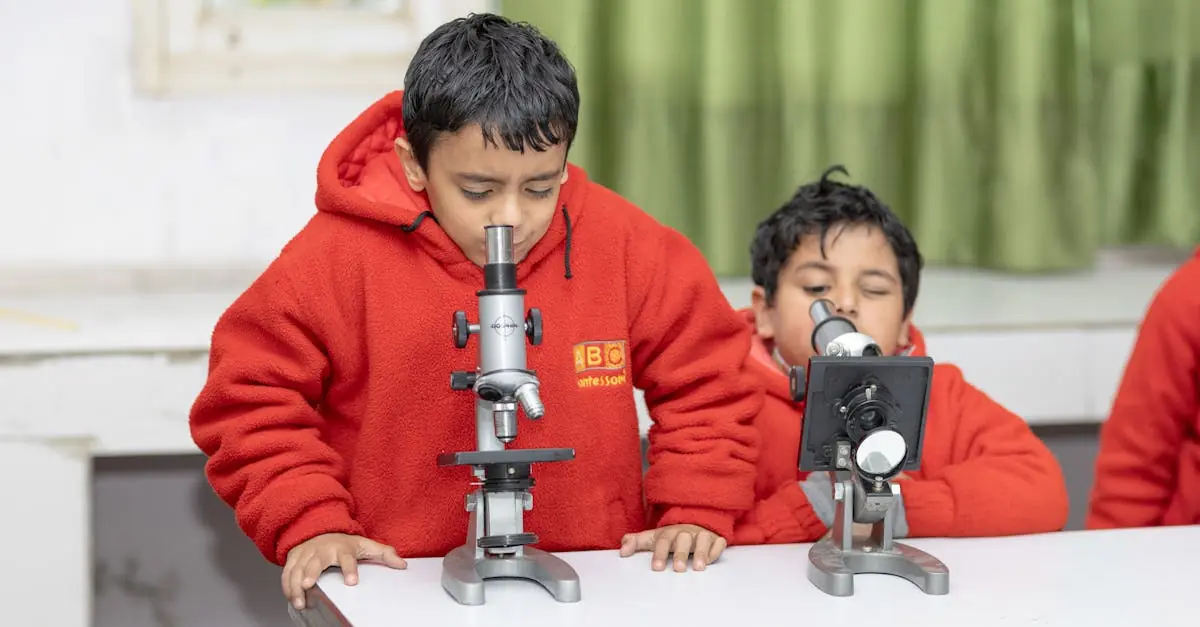STEM might sound like a fancy word for a plant’s body part, but it’s way cooler than that! It stands for Science, Technology, Engineering, and Mathematics—four subjects that help kids unlock the mysteries of the universe. Imagine building robots, exploring outer space, or even creating video games. Sounds like a superhero’s toolkit, right?
Table of Contents
ToggleWhat Is STEM?
STEM stands for Science, Technology, Engineering, and Mathematics. This four-part approach encourages kids to learn through exploration and creativity. Science involves studying the natural world. It includes subjects like biology, chemistry, and physics, which explain how things work.
Technology covers the tools and systems that make life easier. Kids can learn about computers, coding, and devices. Engineering focuses on designing and building. It challenges kids to create structures or machines, fostering problem-solving skills.
Mathematics deals with numbers and shapes. It helps kids understand patterns and relationships. A solid foundation in math supports success in all STEM fields.
Engagement in STEM promotes critical thinking. For instance, constructing a simple robot teaches mechanics. Exploring space concepts introduces astronomy, encouraging curiosity about the universe. Creating video games develops logical reasoning and creativity.
Across the globe, STEM education enhances ability and confidence. Many encouraging hands-on activities make learning enjoyable. Workshops, clubs, and competitions provide opportunities for collaboration and teamwork.
With the right tools, kids can become the next generation of innovators. STEM connects learning to real-world challenges. Exploring these subjects shapes holistic thinkers who can address complex issues. Encouraging participation in this field prepares children for future careers, ensuring adaptability and creativity in a rapidly changing world.
Importance Of STEM Education
STEM education plays a critical role in preparing children for the future. Engaging in these subjects not only fosters knowledge but also develops essential skills.
Developing Critical Thinking
Critical thinking emerges as a vital skill through STEM education. Students learn to analyze problems and evaluate different solutions. They tackle hands-on projects that require logical reasoning. Robotics competitions illustrate this point, as participants must strategize and troubleshoot their designs. Building structures in engineering challenges forces students to consider variables like stability and materials. These experiences cultivate discernment and the ability to make reasoned decisions.
Encouraging Creativity
Creativity flourishes in a STEM-focused environment. It allows students to express ideas through innovative projects. Creating video games encourages them to combine art, technology, and storytelling. Engineering tasks motivate children to invent unique solutions, showcasing their imaginations. Workshops often include open-ended challenges, inviting exploration without limits. Such freedom facilitates a natural curiosity that leads to original thinking. Through these engaging activities, children see the value of creativity in applying STEM concepts.
Key Components Of STEM
STEM consists of four key components: Science, Technology, Engineering, and Mathematics. Each component plays a crucial role in a child’s educational journey.
Science
Science encompasses the study of the natural world. Kids explore biology, chemistry, and physics to understand how things work. Various experiments allow children to observe phenomena firsthand. Engaging in scientific inquiry fosters a sense of curiosity about the environment. Through hands-on activities, kids can learn how to formulate hypotheses and analyze results. Learning in this way promotes critical thinking and observation skills.
Technology
Technology involves the tools and systems shaping our world. Children discover how computers and coding function. They often engage with software applications and digital platforms in their learning. This exposure equips them with essential skills for the future job market. Kids can create websites or develop apps, enhancing their digital literacy. Exploring technology encourages innovative thinking and problem-solving abilities.
Engineering
Engineering focuses on designing and building solutions to real-world challenges. This discipline allows kids to engage in projects that require creativity and logic. They often work on challenges that involve creating structures or devices. Problem-solving becomes a key element as they test and refine their designs. Encouraging collaboration in engineering promotes teamwork and communication skills. Through these experiences, children learn how to apply scientific concepts practically.
Mathematics
Mathematics underlies the understanding of patterns and relationships. Kids learn about numbers, shapes, and measurements in various contexts. Mathematical reasoning enhances their ability to think analytically. Engaging in real-life scenarios helps reinforce mathematical concepts. By solving problems, children develop persistence and resilience. These skills are vital across all STEM fields and contribute to their overall academic success.
Fun Ways To Learn STEM
Engaging kids in STEM can be exciting and dynamic. Fun learning methods create lasting impressions and spark curiosity.
Hands-On Activities
Hands-on activities capture children’s attention and promote active learning. Building model rockets allows kids to explore physics and engineering concepts in a tangible way. Conducting simple chemistry experiments instills a sense of wonder about reactions and properties. Designing a robot using everyday materials fosters creativity and problem-solving skills. Constructing bridges with straws teaches principles of structure and stability. Incorporating art into projects encourages innovation while reinforcing concepts. Young learners enjoy experimenting with various materials, leading to greater understanding and retention of STEM principles.
Interactive Games
Interactive games make STEM entertaining and accessible. Puzzle games focused on coding help kids grasp programming fundamentals while developing logical thinking. Virtual simulations immerse children in real-world scenarios, enhancing their understanding of scientific principles. Math-based board games create enjoyable environments for practicing arithmetic skills. Escape room challenges promote teamwork and critical thinking through collaborative problem-solving. Online platforms offer interactive lessons in a fun format, making learning enjoyable. Gamifying STEM education keeps children engaged and motivated to explore new concepts further.
STEM education opens doors to a world of discovery for kids. By engaging in science technology engineering and mathematics activities they not only learn essential skills but also develop a passion for exploration. These subjects empower children to think critically and creatively tackling real-world problems with confidence.
Through hands-on projects and interactive games learning becomes an exciting adventure. As kids build robots conduct experiments and solve puzzles they cultivate teamwork and communication skills that are vital for their future. Embracing STEM in childhood lays the foundation for a brighter more innovative tomorrow.



